In a world full of pictures and visuals, imagine the possibilities if technology could truly understand and describe them. That’s exactly what large language models (LLMs) with image-to-text capabilities can do. These models don’t just process images—they interpret them, generate detailed descriptions, and extract valuable insights. From helping businesses manage products to improving healthcare, education, and even travel, these models are transforming the way we interact with images. In this blog, we will cover ten popular use cases of image-to-text conversion powered by LLMs.
How to Use LLMs for Image-to-Text Conversion?
Before we move on to the crux of this article, let’s first learn how to use LLMs for image-to-text tasks. Two popular LLMs for image to text tasks are Llama 3.2 90B and GPT-4o. In this blog, we’ll be using GPT-4o, but feel free to choose the one that suits you best.
Let me walk you through how to access GPT-4o.
- Go to https://openai.com/index/chatgpt/.
- Select try ChatGPT and log in using your Gmail account. You will receive 10 free questions for ChatGPT4o every day.
- Click on the paperclip icon and attach the photo.
- Next, type the prompt and click on the Upward arrow.

In this image, I used the prompt “Describe the natural phenomenon shown in the image” and received the desired text description.
You can also use Llama 3.2 90B as your LLM to handle various use cases. If you’re curious about how to use Llama 3.2 90B effectively, check out my blog, titled Llama 3.2 90B vs GPT 4o: Image Analysis Comparison.
Use Cases of Image-to-Text LLMs
Now that you have learned how to use LLMs for image-to-text tasks, let’s look at the list of the most popular use cases:
- Product Description in E-commerce and Advertising
- Medical Image Analysis in Healthcare
- Travel and Tourism: Identify locations :
- Educational Tool: Understanding Diagrams and Chats
- Recipe Generation through images
- Accessibility for Visually Impaired Users
- Identifying Plants and Diseases
- Virtual Customer Support in Automobile and Insurance Companies
- Transform Image flowchart to code files
- Social Media Caption Creation
Let’s begin with the first one.
1. Product Descriptions in E-commerce and Advertising
Managing product catalogs in the world of e-commerce can be time-consuming and repetitive. From crafting detailed product descriptions to assigning accurate tags, the process often requires significant manual effort. But with image-to-text LLMs, these challenges can become a thing of the past. Let me show you how these tools can not only reducer workload but also spark creativity.
Product Naming and Description
Simply upload an image that captures the essence of your product or brand, provide a specific prompt, and let the LLM work its magic. Within seconds, it can generate unique product descriptions and name suggestions that align seamlessly with your brand identity.
For example, imagine a self-care company launching a winter body lotion. They need a unique product name and a compelling description. An LLM simplifies this task, making it quick and efficient.
Prompt: “Generate a product name, tagline and description for the winter body lotion.”
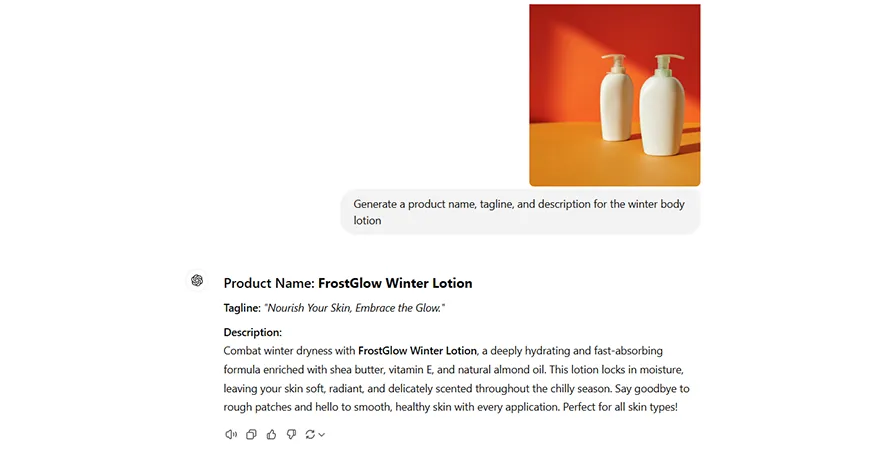
You’ve got your product name, tagline, and description tailored to your product.
2. Medical Image Analysis in Healthcare
Many people struggle to understand medical reports, whether it’s an x-ray, ultrasound, MRI, or even a blood test. These reports can seem overwhelming, especially without a medical background. That’s where LLMs can be incredibly helpful. They can provide initial insights and observations, which medical professionals can then review.
For example:
Suppose you’re looking at this medical image and want to understand the injury and how it might be diagnosed. Use this simple prompt, “Identify the injury shown in this medical image and explain how it can be diagnosed.”

Here’s the response I got:

3. Travel and Tourism: Identify locations
While scrolling through social media, have you ever come across a stunning picture and wondered, ‘Where is this place? I’d love to go here.’ Well, LLMs can help you find the location! They can analyse the image, get you the name of the place, and even help you plan your travel itinerary. Exciting, right? Let’s try this out.
Here’s an image I found on the internet, and I would like to go here sometime.

Now, I’ll just put in this prompt: “Identify the location shown in the image and create a 5-day itinerary for it. “ and let’s see what happens.

As you can see, GPT-4o not only identified the destination but also planned a travel itinerary for me.
4. Educational Tool: Understanding Diagrams and Chats
Having a teacher or guide by your side every time you need help isn’t always possible. But what if you’re stuck trying to understand a map, diagram, or chart in your textbook/course material? LLM-based image-to-text conversion can step in to help!
Imagine you’re a Class 10 student struggling to grasp the functions of the heart’s chambers, valves, and blood flow.

You upload an image of a labelled human heart diagram and type in your question. Let’s try asking it, “Explain the function of the heart’s chamber and valves and provide a simple step-by-step breakdown of how blood flows through the circulatory system.“
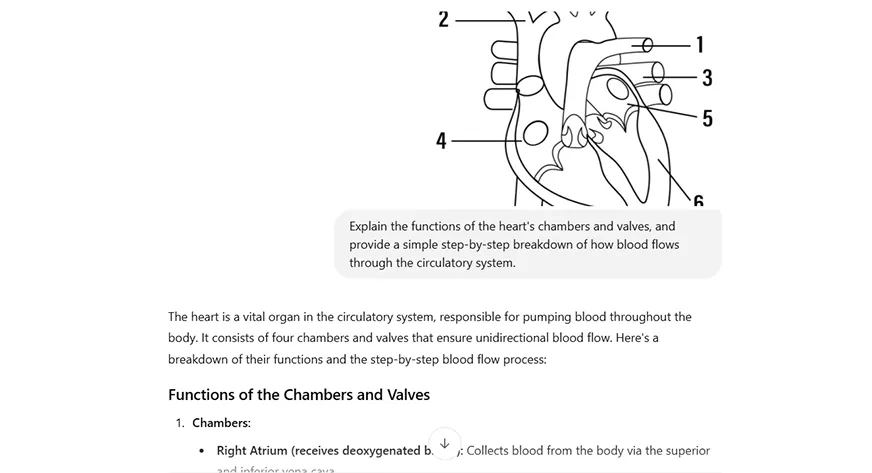
This way, within moments, you can receive a clear and detailed explanation that makes the concept easy to understand. If the generated response is difficult for you to understand or if you need more clarity on any of the terms, you can ask the LLM to explain further through simple follow-up prompts. Tools like LLMs make learning complex topics simpler, faster, and more accessible—right when you need it.
5. Recipe Generation through images
Do pictures of nicely presented yummy food make your mouth water? Have there been times when these images give you food cravings? You see an image of food with a beautiful presentation, and suddenly, you crave to try it, but you have no idea how to make it. Well, here’s where LLMs come to the rescue! By simply uploading the image, you can ask LLMs to identify the dish and provide the recipe to make it yourself.

For example, let’s say I want to know what these colourful biscuits are called and how to make them. Here’s the prompt I’m going to use to find that: “Identify the dish shown in the image and provide the complete recipe, including preparation steps.”
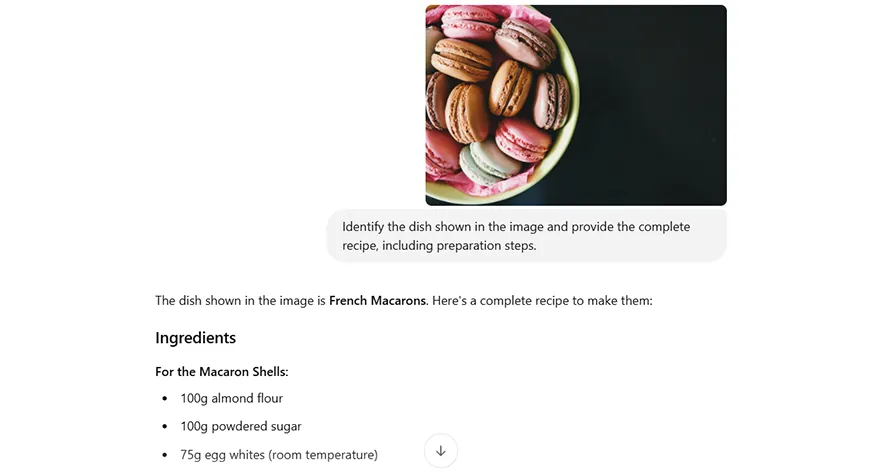
6. Accessibility for Visually Impaired Users
Visually impaired individuals are able to “see” through words – and LLMs do exactly that for them. They bring photos to life by narrating and describing visual content, transforming it into vivid, auditory experiences. For this, they first create a descriptive text of the image and then convert the text into audio.
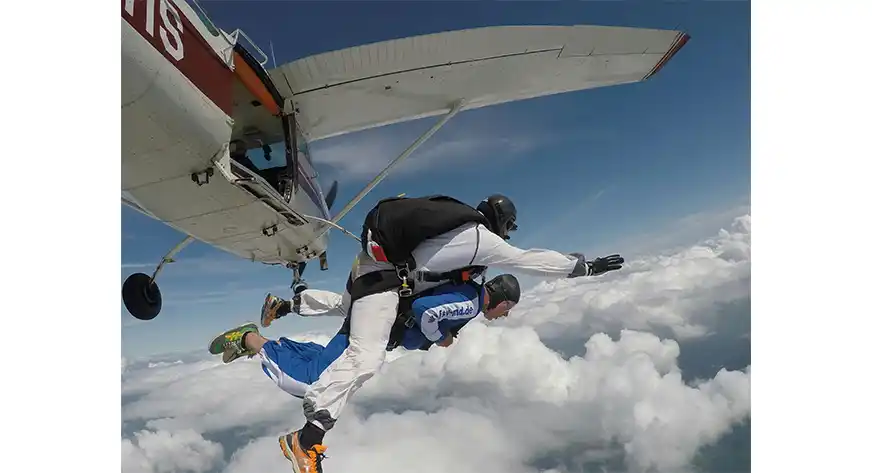
Imagine you want to explain this photo to someone who is visually impaired. You could simply say, “Describe this image to a visually impaired person.”

With that prompt, LLMs can translate visual details into a captivating story, making the unseen tangible.
7. Identifying Plants and Diseases
Gardening and agriculture are getting a high-tech boost with the help of image-to-text conversions.
You can snap a picture of any unknown crop or garden plant, and LLMs can instantly analyse it for you. They can identify the plant, diagnose plant health, spot diseases, and even identify pest infestations. By turning visual insights into actionable text, they provide farmers and gardeners with recommendations to improve yields and ensure sustainable practices.
For instance, say you’ve got a photo of some damaged leaves. Upload it, and give the prompt “Identify the plant in the image, determine the disease it is affected by, and suggest possible remedies for its treatment.”
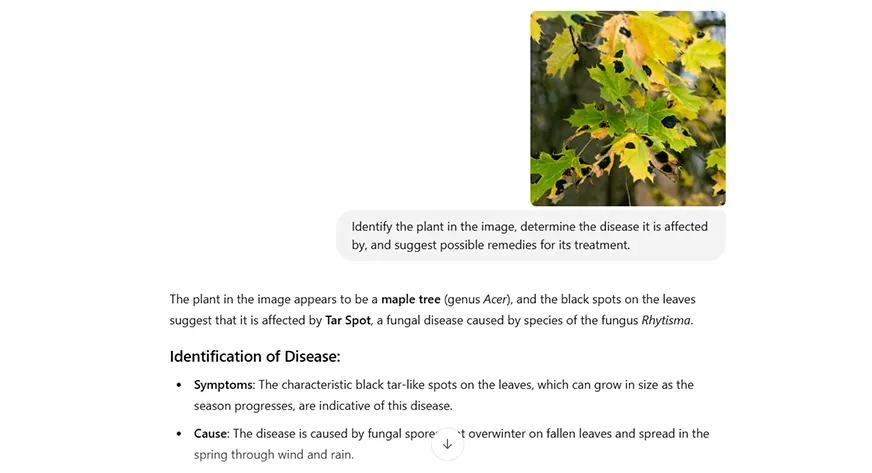
Just like that, you can get an analysis of the plant, the disease affecting it, and a list of treatment options—all at your fingertips. It’s like having a personal plant expert anytime you need it!
8. Virtual Customer Support in Automobile and Insurance Companies
Efficiency and accuracy are key factors in the automobile and insurance industries. To streamline claim processing, virtual customer support agents can revolutionise damage claim handling by using image-to-text conversions.
Imagine a customer is involved in an accident. Instead of contacting an insurance agent and waiting for the claim to process, the customer can simply upload photos of their damaged vehicle to a virtual customer support system. Using an LLM, the customer support team can analyse the images, evaluate the damage, and calculate the percentage of damage done—all within moments. It can even generate a detailed report to support the claim process.
Let me show you an example.
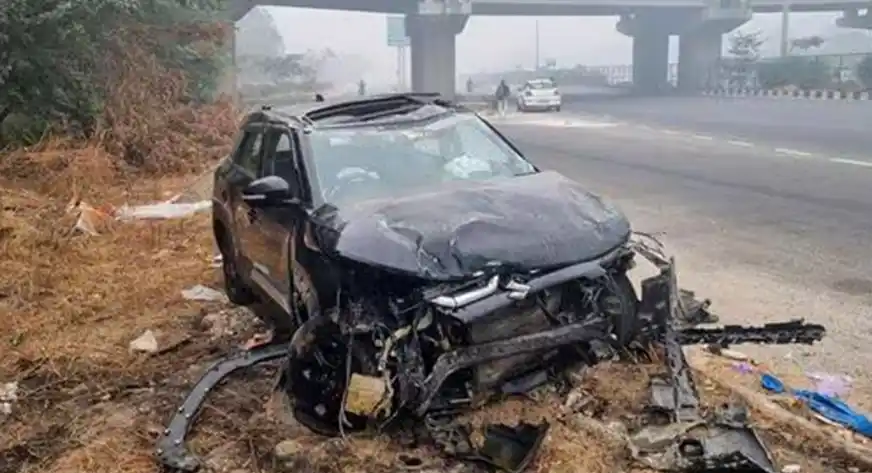
Suppose a customer needs to claim compensation for this car damage. The customer support team can simply upload this photo and prompt the LLM with a query like, “Assess the damage percentage of this car for the claim process.” The LLM will quickly evaluate the damage and provide precise insights.
With this percentage as a basis, the claim can be processed efficiently, ensuring faster settlements. By automating image-based assessments, insurance companies can reduce processing time, improve customer satisfaction, and provide accurate repair cost estimates — all with a seamless, tech-driven solution.
9. Transform Image flowchart to code files
Did you know that LLMs can generate executable code from an image in just seconds? They can analyse and extract the underlying logic from an image, explain it to you, and also show you how to build it. This saves hours of manual work and minimises errors.
For example, imagine you have an image of a transformer flowchart and need the code to execute that process. You can use a prompt like: “Analyze, understand, and describe the image. Then write the Python code to run the process shown in the flowchart.” and obtain the corresponding code.

Do try this for other images and charts. Now, let’s move to the last use case.
10. Social Media Caption Creation
Want to share those fun weekend trip pictures but not sure what to write about them? Crafting the perfect social media post can sometimes feel daunting, even for influencers who struggle to create the perfect captions and hashtags for every post. This is where image-to-text conversion becomes a game-changer, simplifying the process effortlessly.
Just upload your image, and the LLM will craft trending, eye-catching captions and hashtags tailored to your content. Whether it’s a stunning sunset, a mouthwatering plate of pasta, or a stylish outfit, this tool will ensure your posts grab attention and connect with your audience.
Let’s see how an LLM can generate the perfect caption and trending hashtags for this social media post.

You can add more details to your prompt to set the tone, add emojis, create regional or multi-lingual captions, or generate descriptions catering to a specific audience. So go ahead and try this out for your next social media post!
Conclusion
Converting images to text using LLMs is revolutionising the way we interpret and interact with visual data. From simplifying product description and product naming in e-commerce to enhancing accessibility for visually impaired individuals, this technology is reshaping industries and enriching everyday life. By bridging the gap between visuals and language, image-to-text LLMs empower us to unlock actionable insights from the world around us.
Frequently Asked Questions
A. While LLMs are powerful, they are not perfect. They may struggle with very complex images or provide less accurate results if the image is unclear or lacks key details. Therefore, human verification is a critical step to ensure the accuracy and reliability of the output.
A. Yes, image-to-text LLMs can analyse a wide range of images, including abstract or artistic ones.
A. No, you don’t need any technical skills to use image-to-text LLMs.
A. Yes, image-to-text LLMs can be used to build real-time applications, such as customer service, emergency healthcare diagnostics, and interactive travel planning.
A. Yes, image-to-text LLMs can be used to generate captions for social media posts.
 NEWSLETTER
NEWSLETTER






